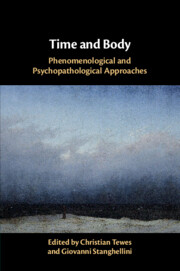Book contents
- Time and Body
- Endorsements for Time and Body
- Time and Body
- Copyright page
- Dedication
- Additional material
- Contents
- Figures
- Contributors
- 1 Introduction – Time and Body
- 2 Time, the Body, and the Other in Phenomenology and Psychopathology
- Part I Body and Time: General Aspects
- Part II Grief and Anxiety
- Part III Borderline Personality and Eating Disorders
- Part IV Depression, Schizophrenia, and Dementia
- 13 Intrinsic Temporality in Depression
- 13.1 Commentary on “Intrinsic Temporality in Depression: Classical Phenomenological Psychiatry, Affectivity, and Narrative”
- 14 Lost in the Socially Extended Mind
- 14.1 Commentary on “Lost in the Socially Extended Mind: Genuine Intersubjectivity and Disturbed Self-Other Demarcation in Schizophrenia”
- 15 Closing Up
- 15.1 Commentary on “Closing Up: The Phenomenology of Catatonia”
- 16 Embodied Selfhood and Personal Identity in Dementia
- 16.1 Commentary on “Embodied Selfhood and Personal Identity in Dementia”
- Index
- References
14 - Lost in the Socially Extended Mind
Genuine Intersubjectivity and Disturbed Self-Other Demarcation in Schizophrenia
from Part IV - Depression, Schizophrenia, and Dementia
Published online by Cambridge University Press: 30 October 2020
- Time and Body
- Endorsements for Time and Body
- Time and Body
- Copyright page
- Dedication
- Additional material
- Contents
- Figures
- Contributors
- 1 Introduction – Time and Body
- 2 Time, the Body, and the Other in Phenomenology and Psychopathology
- Part I Body and Time: General Aspects
- Part II Grief and Anxiety
- Part III Borderline Personality and Eating Disorders
- Part IV Depression, Schizophrenia, and Dementia
- 13 Intrinsic Temporality in Depression
- 13.1 Commentary on “Intrinsic Temporality in Depression: Classical Phenomenological Psychiatry, Affectivity, and Narrative”
- 14 Lost in the Socially Extended Mind
- 14.1 Commentary on “Lost in the Socially Extended Mind: Genuine Intersubjectivity and Disturbed Self-Other Demarcation in Schizophrenia”
- 15 Closing Up
- 15.1 Commentary on “Closing Up: The Phenomenology of Catatonia”
- 16 Embodied Selfhood and Personal Identity in Dementia
- 16.1 Commentary on “Embodied Selfhood and Personal Identity in Dementia”
- Index
- References
Summary
Much of the characteristic symptomatology of schizophrenia can be understood as resulting from a pervasive sense of disembodiment. The body is experienced as an external machine that needs to be controlled with explicit intentional commands, which in turn leads to severe difficulties in interacting with the world in a fluid and intuitive manner. In consequence, there is a characteristic dissociality: others become problems to be solved by intellectual effort and no longer present opportunities for spontaneous interpersonal alignment. This leads to a loss of the socially extended mind, which normally affords opportunities for co-regulation of cognitive and affective processes. However, at times people with schizophrenia report that they experience the opposite of dissociality, namely, an unusual fluidity of the self-other boundary as expressed in experiences of ambiguous body boundaries, intrusions, and even merging with others. Here, the person has not lost access to the socially extended mind but has instead become lost in it, possibly due to a weakened sense of self. We argue that this neglected aspect of schizophrenic social dysfunction can be usefully approached via the concept of genuine intersubjectivity: we normally participate in a shared experience with another person by implicitly co-regulating how our interaction unfolds. This integrates our respective experiences’ dynamical bases and gives the interaction an ambiguous second-person character. The upshot is that reports of abnormal self-other fluidity are not indicative of hallucinations without any basis in reality, but of a heightened sensitivity and vulnerability to processes of interpersonal alignment and mutual incorporation that form the normal basis of social life. We conclude by discussing implications of this view for both the science of consciousness as well as approaches to intervention and therapy.
- Type
- Chapter
- Information
- Time and BodyPhenomenological and Psychopathological Approaches, pp. 318 - 340Publisher: Cambridge University PressPrint publication year: 2020

